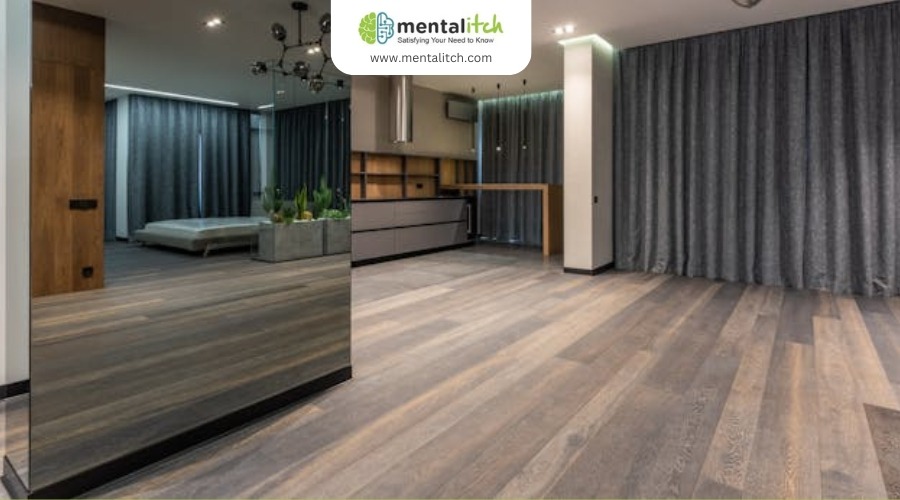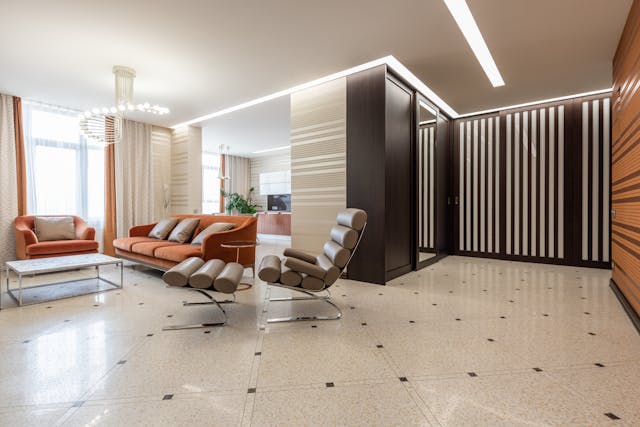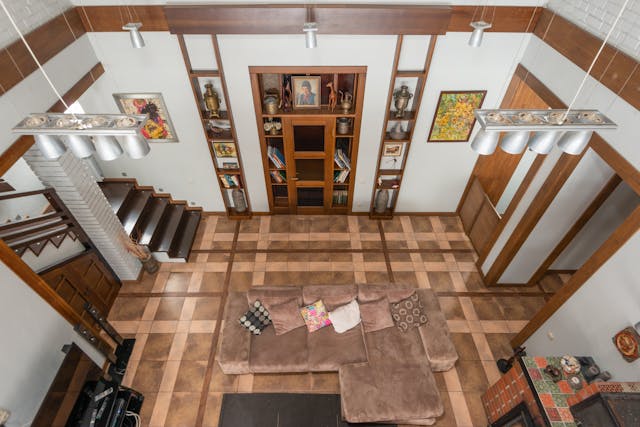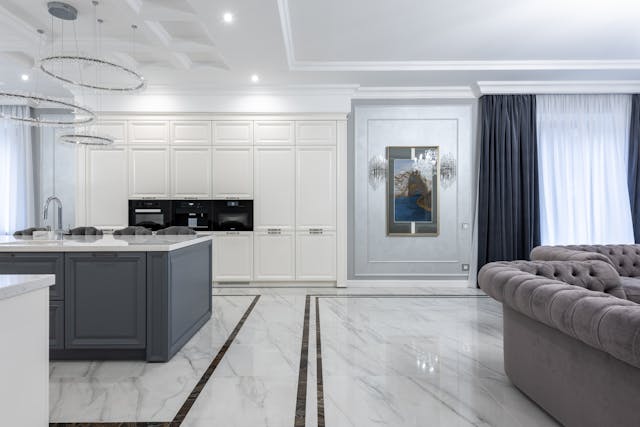When you’re looking to give your home’s flooring a facelift, blending different types might seem like walking a tightrope. You want to combine hard surfaces like hardwood or luxury vinyl with soft ones like carpet without the space feeling disjointed. It’s not just about picking materials that look good next to each other; it’s about creating a cohesive flow throughout your home. Understanding how to mix textures, colors, and materials while maintaining harmony between rooms can be a bit of an art form.
Let’s explore how to master this balance, ensuring your floors elevate your home’s aesthetic without overpowering it.
Understanding Flooring Combinations
To masterfully blend different flooring types in your home, it’s essential to grasp how various materials can complement and enhance each other. By understanding flooring combinations, you’re not just mixing flooring types; you’re carefully selecting and combining different types of flooring to create a space that’s uniquely yours. This process involves more than just aesthetics; it’s about adding visual interest, texture, and depth to your rooms, achieving a cohesive look that flows seamlessly from one area to another.
Blending different flooring options allows for the creation of distinct zones within your home, each defined by its purpose and style. Whether you’re combining hardwood with tile in your open-plan living area or carpet with vinyl in your bedrooms, the key is to understand how these materials work together. Not only does this add to the design and functionality of your space, but it also ensures that your flooring choices reflect your personal style.
Room Size and Purpose
Understanding how different flooring types can complement each other sets the stage for considering room size and purpose in your flooring decisions. When selecting flooring, it’s crucial to reflect on how each room will be used. For instance, heavy-duty materials are a must in high-traffic areas to ensure they can withstand the wear and tear of daily life. Similarly, rooms prone to moisture – like bathrooms or kitchens – benefit from moisture-resistant flooring, safeguarding your investment and maintaining the quality of your space.
To make your decision process smoother, consider these key points:
- Differentiate room functionalities: Use varied flooring types to signal the distinct purpose of each area within your home.
- Opt for durability: In high-traffic zones, prioritize materials that promise longevity.
- Seek moisture resistance: In wet areas, choosing the right material can prevent potential damage and maintain the room’s integrity.
Architectural Style Compatibility
When choosing flooring, you must consider how it complements your home’s architectural style. Whether you’re leaning towards historical influences or modern design principles, the right selection can significantly elevate your space.
An eclectic approach also offers the flexibility to mix elements for a unique, personalized look.
Historical Influences on Design
While exploring the world of home renovation, it’s crucial to recognize how architectural styles such as Victorian, Craftsman, and Mid-Century Modern significantly influence your flooring choices and transitions. Historical influences play a pivotal role in ensuring that your flooring choices not only reflect your aesthetic preferences but also respect the authenticity and craftsmanship inherent in your home’s design. By aligning your flooring with the architectural style, you maintain the historical integrity and enhance the overall appeal of your space.
- Historical homes often feature specific flooring materials like hardwood, tile, and stone to maintain authenticity.
- Flooring designs reflect the time period’s aesthetic preferences and craftsmanship.
- Compatibility between flooring types and architectural styles is essential for preserving historical integrity.
Modern Design Principles
In modern design principles, matching your home’s architectural style with the right flooring type is key to achieving a cohesive and visually appealing space. Opting for wood flooring or a tile and wood combination can offer a modern look that complements an open floor plan.
Mixed flooring types, when chosen carefully, can delineate different areas within your home without disrupting the overall flow. By selecting flooring ideas that blend different colors and materials, you’re not just creating visual interest; you’re also ensuring that high-traffic areas have heavy-duty flooring for durability and wet areas have moisture-resistant materials.
This strategy of blending different flooring types while considering functionality and architectural style allows for a harmonious and stylish home environment.
Eclectic Approach Benefits
Adopting an eclectic approach to blending different flooring types can significantly enhance your home’s architectural style compatibility, offering a personalized and visually captivating design. By mixing various flooring materials, you’re not just laying a foundation; you’re crafting a narrative for each room. This method allows you to match the unique character of your space with the right mix of colors and textures, seamlessly transitioning from hardwood in the living room to tile in the kitchen.
- Personalization: Tailor each room to reflect your personal style by mixing different flooring.
- Visual Interest: Add depth with a variety of textures and colors.
- Harmony and Balance: Achieve a cohesive look that flows smoothly from one room to another.
This eclectic approach ensures your home stands out, blending form, function, and flair.
Selecting Harmonious Colors
Selecting harmonious colors can significantly enhance the visual flow between different flooring types, creating a seamless and unified space. When you’re blending different colors in every room, it’s crucial to aim for a harmonious blend that maintains a cohesive look throughout your home. Achieving this balance involves focusing on matching color tones across various flooring materials to ensure visual flow and unity.
To create this cohesive effect, using a color wheel can be incredibly helpful. It allows you to identify complementary colors that, when used together, create a pleasing and harmonious design. This tool is particularly useful when you’re dealing with a variety of flooring types and need to find a common ground that ties everything together.
Consistency in your color choices is key to achieving a harmonious design. It’s not just about selecting colors that match perfectly but about finding a balance that works across the different spaces in your home. By paying close attention to the color tones and aiming for consistency, you can create a sense of continuity that enhances the overall aesthetic of your space, ensuring that each room feels connected yet unique.
Impact on Home Décor
How does blending different flooring types transform your home’s décor? When you mix flooring types, such as wood with tiles, you’re not just choosing a practical solution for different areas of your home; you’re also making a statement. This creative decision can significantly influence the overall aesthetic and feel of your space. Let’s explore how your choice impacts your home’s décor:
- Seamless Transitions: Careful blending of different flooring types can create smooth transitions from one room to another. This doesn’t just elevate the look of your home; it also crafts a cohesive and harmonious atmosphere that flows beautifully throughout your space.
- Defining Spaces: By mixing flooring types, you can effectively define different functional zones within your home. This approach allows for a more organized and visually appealing layout, enhancing both the functionality and the aesthetic appeal of your rooms.
- Adding Visual Interest: The right combination of flooring materials can add depth and visual interest to your home décor. Wood floors next to sleek tiles, for example, can introduce a dynamic contrast that captivates and delights, making your home stand out with creative design choices.
Blending different flooring types isn’t just about practicality; it’s about infusing your home with personality and style, making every corner a reflection of your unique taste.
Mixing Flooring Do’s and Don’ts
When you’re blending different flooring types, it’s crucial to match their heights for a smooth transition between spaces. You’ll also want to consider color harmony, ensuring the tones complement rather than clash with each other. Mastering transition techniques is key to achieving a seamless look that ties your rooms together.
Match Flooring Heights
To ensure a seamless transition between different types of flooring, it’s crucial to match their heights. When mixing flooring types in one area, such as hardwood flooring with other flooring materials, paying attention to matching flooring heights can prevent uneven surfaces that pose tripping hazards. Furthermore, a flooring installation that aligns heights across different materials maintains a polished look and contributes to a visually pleasing interior.
- Prevent Tripping Hazards: Uneven flooring can lead to accidents.
- Maintain A Cohesive Look: Consistent heights keep the flow between rooms smooth.
- Enhance Aesthetic Appeal: Attention to detail in height matching elevates the overall design.
Consider Color Harmony
Achieving harmony in your home’s aesthetic requires careful consideration of flooring colors to ensure they complement each other and the overall decor. Using a color wheel can guide you to a balanced and harmonious mix, avoiding clashing colors that disrupt flow. Pay attention to undertones for a seamless and coordinated design, creating a cohesive and visually pleasing look.
| Aspect | Do | Don’t |
|---|---|---|
| Color Selection | Use a color wheel for guidance | Choose clashing colors |
| Undertones | Consider undertones carefully | Ignore undertones |
| Overall Decor | Ensure colors complement decor | Disregard room’s decor |
| Harmony | Aim for a cohesive look | Sacrifice harmony for trends |
Transition Techniques Mastery
Mastering transition techniques is essential for seamlessly blending different types of flooring in your home. To achieve a cohesive look, you’ll need to carefully select and install transition pieces that not only match your flooring materials but also manage floor height differences effectively. Here’s how to ensure your transitions are as smooth as possible:
- Choose transition strips like T-molding, reducers, or end caps to gracefully manage differences in floor height.
- Pick transition pieces that complement both flooring types to avoid abrupt contrasts and create a polished appearance.
- Ensure your subfloor is clean and level before installing any transition elements for the best results.
Ideas for Tile Integration
Integrating tiles into your flooring design offers endless possibilities to enhance both function and aesthetics. When you’re considering tile integration, mixing different tile sizes and shapes can create a visually dynamic look that captures the eye. Creating patterns with tiles adds interest and personality to your space, turning the floor into a statement piece. Additionally, using contrasting grout colors can highlight these patterns and designs, offering an extra layer of detail that truly makes your flooring pop.
Incorporate mosaic tiles as accents to break up larger expanses of tile, providing a unique touch that can differentiate areas without the need for physical barriers. Combining different tile textures not only adds to the visual appeal but also offers a tactile experience, making your flooring design not just a treat for the eyes but also for the feet.
| Tile Integration Ideas | Description | Application Example |
|---|---|---|
| Mix Sizes & Shapes | Combine various tile sizes and shapes | Living room floor design |
| Pattern Creation | Use tiles to create distinct patterns | Kitchen backsplash |
| Texture Combination | Blend different textures for a rich feel | Bathroom floor and walls |
Soft and Hard Surface Blends
Blending soft and hard surfaces in your home’s design creates a harmonious balance, offering both durability and comfort tailored to your lifestyle. By mixing elements like plush carpets with sturdy hardwood or tile, you achieve a versatile design that caters to both functionality and aesthetic appeal. Soft surfaces add a layer of comfort, making spaces feel more inviting, while hard surfaces provide the durability needed in high-traffic areas.
Consider these benefits of blending soft and hard surfaces in your design:
- Visual Interest and Texture: Combining different materials adds depth and character to your rooms.
- Customization: Tailor the mix to suit the functionality of each space, whether it’s a cozy bedroom or a bustling kitchen.
- Balance of Comfort and Durability: Enjoy the best of both worlds with areas that are both comfortable underfoot and easy to maintain.
Incorporating soft surfaces like rugs on top of hard flooring not only softens the look and feel of a space but also maintains the durability essential for areas like living rooms and hallways. This strategic blending enhances the overall aesthetic of your home, making it uniquely yours.
Final Thoughts on Mixed Flooring
Having explored the harmonious combination of soft and hard surfaces, let’s now focus on wrapping up our thoughts on mixed flooring. Blending different types of flooring throughout your home isn’t just about achieving a unique look; it’s about leveraging the strengths of each material to enhance the aesthetic appeal and functionality of your living spaces. By choosing to mix and match, you’re embracing a versatile design approach that allows for personalization at every turn.
Remember, the key to a successful blend lies in seamless transitions and thoughtful color coordination. These elements ensure that your space maintains a cohesive spatial flow, preventing the mixture of materials from feeling disjointed. Whether you’re balancing the warmth of hardwood with the comfort of carpet or combining the durability of tile with the natural beauty of stone, each choice should contribute to the overall aesthetic you’re aiming to achieve.
Ultimately, mixed flooring offers a dynamic solution for those looking to infuse their homes with character and flexibility. By carefully considering factors like foot traffic, functionality, and personal taste, you can create a home that’s as functional as it’s visually appealing.
Additional Details:
- Learn more about hardwood flooring options.
Conclusion
In conclusion, blending different flooring types in your home isn’t just about aesthetics; it’s about creating zones, enhancing functionality, and complementing your home’s architectural style. Remember to pick harmonious colors and consider the room’s size and purpose when mixing hard and soft surfaces.
Don’t shy away from using transition pieces for a seamless look. By following these tips, you’ll ensure your mixed flooring choices add both beauty and practicality to your living spaces.



